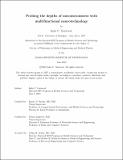Probing the depths of unconsciousness with multifunctional neurotechnology
Author(s)
Garwood, Indie C.
DownloadThesis PDF (53.34Mb)
Advisor
Brown, Emery N.
Anikeeva, Polina
Terms of use
Metadata
Show full item recordAbstract
Innovation in the interrelated fields of anesthesia and psychiatry demands an improved understanding of the mechanisms behind altered states of consciousness. Studying the brain's functional equilibrium, and how it can be disrupted, has motivated increasingly high resolution and multifunctional neurotechnology. Inferring the dynamic structure of neuronal signaling from high dimensional data requires concomitant computational advances. This thesis focuses on how the intersection of neuroscience, engineering, and statistics can be leveraged to unravel the mechanisms behind altered consciousness induced by high-dose ketamine. Although ketamine has been indispensable to medical practice since 1970, the neurobiological mechanisms behind its unique behavioral effects are not fully understood. I hypothesized that ketamine’s inhibition of N-methyl-D-aspartate receptors (NMDARs) leads to a systemic restructuring of both chemical and electrical neuronal signaling which ultimately disrupts consciousness. Systematically testing this hypothesis required the ability to probe electrochemical signaling across the behavioral spectrum spanning cognition and unconsciousness. To enable this study, I first developed multifunctional fiber-based neurotechnology capable of simultaneously recording and modulating cortical and deep brain electrochemical signaling in non-human primates. Second, I developed a state-space model framework for characterizing the structure of neural activity and its dynamic response to neuromodulation. Using these developments, I found that ketamine's systemic alteration of electrochemical signaling results in rigidly structured neural activity that disrupts communication between brain areas, resulting in loss of consciousness. This work furthers our understanding of the neural dynamics that define unconsciousness, while also empowering systems neuroscience with an integrated, generalized toolbox for characterizing neuropharmacology.
Date issued
2023-06Department
Harvard-MIT Program in Health Sciences and TechnologyPublisher
Massachusetts Institute of Technology